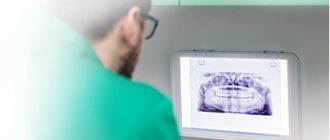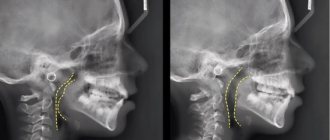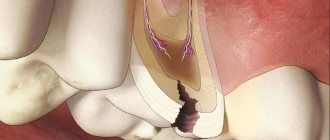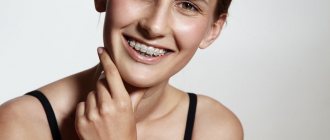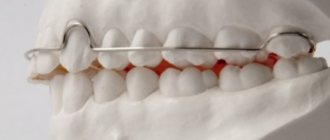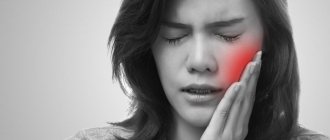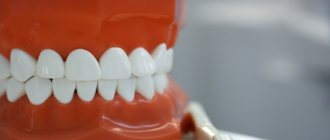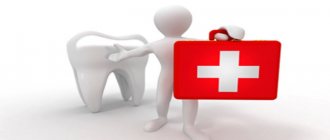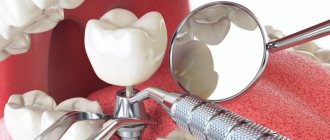Orthodontics is a branch of dentistry aimed at correcting defects in the development of teeth and the maxillofacial skeleton. The result of orthodontic treatment largely depends on the correct diagnosis. Modern diagnostics in orthodontics
performed using special devices and equipment.
In this article we will consider popular methods of orthodontic diagnostics and answer frequently asked questions about orthodontics
.
Diagnostic methods in orthodontics
The treatment of defects of the masticatory-speech apparatus is carried out by a specialized orthodontist. After a visual examination of the patient’s oral cavity, the specialist decides on the need to conduct additional research procedures using modern diagnostic methods. Based on the analysis obtained, it is possible to establish an accurate diagnosis and select the correct treatment to achieve a successful result.
Diagnostic methods in orthodontics:
1. Radiography.
2. Tomography of the temporomandibular joint.
3. Orthopantomography.
4. Examination using diagnostic models (taking impressions of the patient’s jaw with subsequent production of working models).
5. Electromyography.
6. Mask model (determining facial asymmetry taking into account three planes).
7. Simon's photostat.
8. Teleradiography.
The most popular diagnostic methods in orthodontics are dental radiography and orthopantogram, which allow identifying various deviations of the dentofacial apparatus. In difficult cases, additional research methods are used to clarify the identified pathologies.
Taking dental impressions
Nowadays, few people do calculations using models; they are created more formally. In general, all this can be done using computed tomography, provided the orthodontist has sufficient knowledge and skills. Using plaster models, the orthodontist calculates the size of the teeth, the amount of space required to move them, looks at the proportionality of the teeth, whether restoration will be required, and how they will fit together after treatment.
Why do we continue to make impressions at the Confidential Clinic?
At the Confidence clinic, we do not treat the patient so that he has straight teeth and everything is fine only according to calculations. We treat so that your smile is beautiful in real life.
The first and most important reason is the need for models for indirect fixation. The second reason is that they provide an opportunity to once again see some real object live, because CT and TRG are virtual things, and models make it possible to visually see the patient’s bite.
It happens that an orthodontist, during the treatment process, encounters some unexpected effect for him and is lost. At the Confidence clinic, we calculate everything “on the shore” in order to continue strictly according to the treatment plan, which we drew up even before fixing the braces.
Questions about orthodontics
Many patients have different questions about orthodontics. Let's look at the most popular ones.
Is it possible to correct dental defects without braces?
The vestibular brace system is by far the most effective way to correct bite defects. But as an alternative, the patient may be offered aligners. A set of mouth guards is made from impressions taken from the patient’s jaw. While wearing them, you must maintain careful oral hygiene. The orthodontic structure is changed once a month. The patient needs to regularly visit an orthodontist to monitor the treatment process.
Cons of aligners:
- Not suitable for everyone;
- not used in complex cases;
- are more expensive than braces.
How quickly do teeth straighten with braces?
On average, teeth move into an even arch after 3-4 months. These periods can be shortened or increased, depending on the type of braces chosen and the complexity of the particular case.
What is the function of orthodontic screws?
Screws in orthodontics
are used to stabilize the brace system in the absence of some teeth in a row, as well as in case of bone tissue atrophy. They eliminate the movement of supporting teeth and speed up the process of dental correction.
How do teeth move?
In some cases, it becomes necessary to move one or more teeth. For this purpose, orthodontists use removable or non-removable structures. Fixed bracket systems include bracket systems that ensure the movement of teeth in the desired direction, under the supervision of a specialist.
Types of tooth movement in orthodontics
:
1. Corpus technique, which involves moving the tooth crown and root in one direction.
2. Oblique-rotational – involves moving the crown and tooth root to different distances.
In orthodontic treatment, it is possible to move not only one tooth, but also a whole series. This technique is successfully used in the treatment of occlusion with a distal position of the lower jaw.
When are orthodontic implants installed?
When treating complex defects of the dental system, there is often a need to install orthodontic implants aimed at providing the necessary support for fixed structures that correct bite defects.
Indications for installation of orthodontic implants:
- crowded dentition;
- strong protrusion of molars or front incisors;
- distal bite;
- severe curvature of teeth;
- if it is necessary to change the size or position of the jaw;
- to ensure the required degree of impact on the dentition (if braces do not cope with this task);
- lack of positive results after wearing braces for a long time.
Implants in orthodontics
differ from standard designs used to restore lost teeth. They are smaller in size and thickness, are installed temporarily, and the implantation method itself is minimally invasive and does not require cutting the gums or suturing.
How will be correct?
Now we will tell you what steps our diagnostic presentation consists of.
Analysis of diagnostic models.
An electronic caliper is used to calculate the space deficit for each tooth on a plaster model of the jaws. The data is transferred to the presentation.
Analysis of X-ray images.
The data is calculated in special computer programs. Based on them, the main conclusions are drawn.
Assessment of periodontal status (level of gums and frenulum).
Assessment of facial parameters.
The main questions at this stage are: is it possible to delete? Won't this spoil the profile? Even if removal is required due to the bite, the face is always a priority.
Assessment of smile and incisor visibility at rest.
It is important to understand which teeth are more visible when speaking - the upper or lower ones. It has been proven that greater visibility of the upper teeth significantly makes the face look younger and more attractive. It works better than any anti-aging cream One of the basic goals of any treatment.
It has been proven that greater visibility of the upper teeth significantly makes the face look younger and more attractive. It works better than any anti-aging cream One of the basic goals of any treatment.
Width of a smile.
The more teeth you see in a smile, the wider and more open it appears.
Expressiveness of the smile line.
The most charming smile is considered to be the one that closely follows the contour of the lower lip. Also the basic goal of any treatment. More details about the canons of the beauty of a smile are written in our article - What is a beautiful smile.
Planning the positioning of braces on the teeth according to the findings of the smile analysis.
As you can see, half an hour spent in the chair by the patient results in a lot of “behind the scenes” work for the thoughtful orthodontist.
Treatment planning is creative, painstaking work. Unfortunately, not all orthodontists these days fully understand this process. They are not ready to lay this foundation, without which it is impossible to build good and stable treatment in the long term.
Orthodontics is not about fixing braces. Teeth can be as straight as desired, but the smile, nevertheless, remains very mediocre, the profile of the face - spoiled by removal “in the name of teeth.”
Our treatment directly affects the appearance, because the result remains with the patients forever! Therefore, the fundamental point in treatment is only the right choice of doctor!
The main thing is to get into reliable, experienced hands. And if you are reading this, then you are already on the right track!
Orthodontic treatment of bite defects in
Experienced orthodontists who see patients at the specialized dental clinic “Aesthetics” are ready to answer all your questions about orthodontics. The center is equipped with modern diagnostic equipment that gives highly accurate results, which guarantees a quick correct diagnosis and the correct choice of treatment protocol.
Orthodontic treatment uses high-quality lingual braces, mouth guards, plates and other structures that can effectively eliminate various malocclusion defects, even in the most difficult cases. You can make an appointment with an orthodontist by phone. The first consultation appointment is free.
All patients who leave reviews on our website are guaranteed to receive an additional 3% discount on everything dental (the discount is added to the client’s main discount). Share your opinion and experience of orthodontic treatment in our clinic, do not miss the opportunity to save your own money on the services of an experienced orthodontist!
What is diagnostics through the eyes of the doctors at our clinic?
More than one (!) hour of work in the clinic to create a presentation after the diagnosis, which will contain conclusions on a large number of evaluation criteria. Why is this happening?
You need to understand that all doctors have completely different approaches to analyzing diagnostic data.
Some people don’t do it at all and are ready to lay out a treatment plan immediately during the consultation without the slightest doubt. And this, in general, does not indicate high qualifications, rather the opposite.
For some doctors, one panoramic (overview) image and casts are enough. Which is also unacceptable for a modern orthodontist.
Indications for wearing removable appliances
It is better, of course, to take your child to the orthodontist on a preventive basis once every six months, at least to understand whether he needs treatment or not. The classic indicator is a small jaw. Let's say a patient was at the dentist and was told that his jaw was small and his teeth would erupt crookedly. Or an incorrect bite - the upper jaw overlaps the lower jaw too much. Or the child has a bad habit - mouth breathing, which stems from problems with the ENT organs. The ENT doctor also refers you to an orthodontist with this problem.
How to motivate a child for treatment?
It is very important to properly motivate your child. If a child is not motivated, he will not wear anything. The orthodontist’s task is to explain that the child needs this, that he will be beautiful, that this is his future, that this is his smile.
In the practice of our orthodontists, children usually do not tell their parents honestly. Then the doctor asks the parents to leave. Children usually admit that they do not wear them all the time. There is always a reason in such situations. If they laugh at school, then you need to agree that the child wears it only at night and on weekends, when he does not go to school. But if this is unacceptable, then wear the device at night, at home, on weekends.
3D cephalometric analysis of a CT image (a modern alternative to two-dimensional TRG images)
Standard TRG analysis includes an assessment of the position of the teeth already in the space of the skull and how the teeth stand relative to the jaws, how the jaws are located relative to the skull, and what size they are.
3D diagnostics is a much larger amount of information compared to what we see from TRG. Additionally, a CT scan evaluates the position of each tooth in the bone tissue, the therapeutic condition of the teeth, and the condition of the root canals of pulpless teeth. It is only possible to accurately assess the causes of malocclusion pathology and understand what is causing it - a decrease in the size of the jaw or its displacement - only with the help of 3D diagnostics.
Without 3D computed tomography, a full diagnosis is impossible today - this one image replaces and unites everything.
Unfortunately, not all orthodontists have tomographs and are able to analyze 3D images. Now this is the gold standard for all diagnostics and a huge plus for the patient, because not only the orthodontist, but also any other doctors involved in the treatment can take a comprehensive approach to a single, verified treatment plan using just one CT image.


